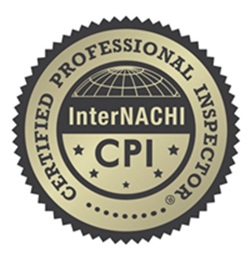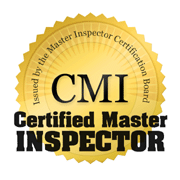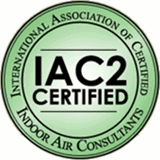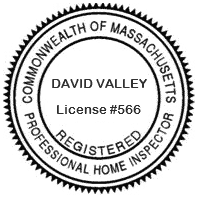Massachusetts Home Inspections YOUR INVESTMENT IS MY CONCERN

Radon In Water

Radon is a naturally-occurring radioactive gas that may cause cancer, and can be found in well water. Some people who are exposed to radon in drinking water may have increased risk of getting cancer over the course of their lifetime, especially lung cancer.
HOW DOES RADON GET INTO WELL WATER?
When the ground produces radon, it can dissolve and accumulate in water from underground sources (called ground water), such as wells. When water that contains radon is run for showering, washing dishes, cooking, and other uses, radon gas escapes from the water and goes into the air. Some radon also stays in the water.
Radon can be a concern if your drinking water comes from a well that draws from an underground source, though not all water from underground sources contains radon. If you get your water from a public water system that serves 25 or more year-around residents, you should receive an annual water quality report. These water quality reports include information on what is in your water, including radon if it has been tested.
Radon from lakes, rivers, and reservoirs (called surface water) is of much less concern. Most of the radon is released from the water before it enters the distribution system. Radon gas can enter the home through well water. It can be released into the air you breathe when water is used for showering and other household uses. Research suggests that swallowing water with high radon levels may pose risks, too, although risks from swallowing water containing radon are believed to be much lower than those from breathing air containing radon.
While radon in water is not a problem in homes served by most public water supplies, problems have been found in well water. If you've tested the air in your home and found radon levels exceeding government standards (4 (four) Pico curies per liter (pCi/L) or higher) and your water comes from a well, Certified Massachusetts Home Inspections will gladly take a water sample and have our local Certified Lab determine if radon exists in your well water. I can get the results back to you within two working days. If you're on a public water supply and are concerned that radon may be entering your home through the public water, call your local water supplier.
Unsafe Radon levels in well water vary from State to State. No standard has received a consensus, partly because the health impacts are largely indirect and depend upon varying factors (such as ventilation and water use habits. Some States do have set guidelines for follow-up action.
How radon can be removed from drinking water
Radon can be removed from your water by utilizing several methods...
-AERATION TREATMENT
Radon gas can be easily removed from drinking water by the process known as aeration (See illustration below). Aeration can achieve over 99 percent removal of radon gas from water. The process consists of mixing large volumes of clean filtered air with the well water. The moist radon laden air is discharged outside the home. These systems are considered to be the most effective treatment systems in reducing radon levels in water. They typically cost between $3,500 (for kitchen sink area only) and $6,000 (for a whole house system) and must be properly designed to prevent fouling by iron, iron bacteria or water hardness. As with all mechanical/electrical devices, aerators will eventually need repair (more likely after approximately five years). Removal of iron or manganese, where necessary, will result in higher cost.
Maintenance Costs - An aeration device may need cleaning every six to twelve months depending on the water quality. Approximate cleaning cost (consisting of flushing, disinfecting and air filter replacement by a water treatment professional) may have a cost of $150-$200 per visit. Proper cleaning (by the homeowner) is also possible.
AERATION TREATMENT
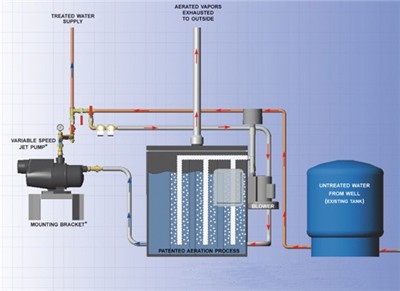
-GAC TREATMENT
Granulated Active Carbon, which similar to charcoal, is effective in removing radon gas from drinking water (See Illustration below). The water is passed through the GAC, which is placed in a water treatment tank, and the entire system works under pressure. There are minimal moving parts in a GAC type treatment system. The cost of a GAC treatment system, installed and guaranteed by water treatment professionals, is approximately $2,000.
Maintenance Costs - GAC replacement can be costly. When considering GAC treatment, determine the expected cost of periodic replacement of the media.
Any aeration or GAC treatment system must be approved by the Bureau of Building Water Systems in the Department of Commerce. Call the DNR Bureau of Water Supply for consultation before installing any treatment system.
CAUTION: Department of Environmental Services does not generally recommend GAC for radon removal, since radioactivity will build up on the carbon. In some cases this could make the carbon in the treatment container too radioactive to be near (in the basement or floor above) and would result in very expensive disposal.
Some technical authors have suggested that GAC is a reasonable treatment method for radon in water for concentrations below 5,000 pCi/L. DES is considering this recommendation further. In addition to radon, mineral radioactivity may in some cases also be removed by GAC. This removal process may be enhanced in the presence of iron (and possibly manganese). Thus the concentration of mineral radionuclides and iron /manganese should be evaluated and be very low before considering the use of GAC.
GAC Disposal - The GAC should be replaced on a periodic basis to prevent excessive radionuclide buildup. Department of Environmental Services suggests that the GAC canister, when first installed, should be labeled "REPLACE CARBON ANNUALLY" in large letters oriented on the canister so as to be easily seen.
GAC TREATMENT
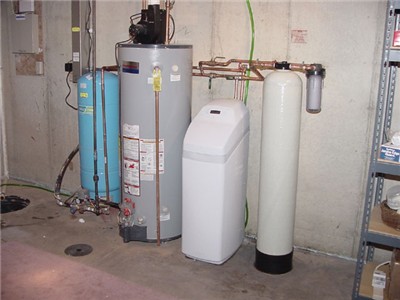
-CONNECT TO A PUBLIC WATER UTILITY
Or you can connect to your neighbor's well which has already been tested for radon and the levels are low. Using bottled water for drinking will reduce your risk from any radon ingestion but it will not eliminate the serious problem of radon gas escaping from your well water and into your household air.
-CONSTRUCTING A REPLACEMENT WELL
This should be considered only as a last resort. This is a very expensive option and will not necessarily yield water with lower radon levels.
In either treatment, it is important to treat the water where it enters your home (a point-of-entry device) so that all the water will be treated. Point-of-use devices such as those installed on a tap or under the sink will only treat a small portion of your water and are not effective in reducing radon in your water. It is important to maintain home water treatment units properly because failure to do so can lead to other water contamination problems. I highly recommend homeowners use a service contract from the installer to provide carbon replacement and general system maintenance.
For additional information on Radon in Water, you should contact your State Radon Office. In Massachusetts call 617-242-3035.
Here is what my clients have to say about my home inspection services:
Press F5 (on your keyboard) for additional testimonials
Hi Dave,
Just wanted to send you a note of appreciation related to our home inspection at 14 Sunset Rock. We found your approach to be thorough, with great attention to detail, along with balanced and very practical advice. We are very pleased with your work!
Regards,
John


